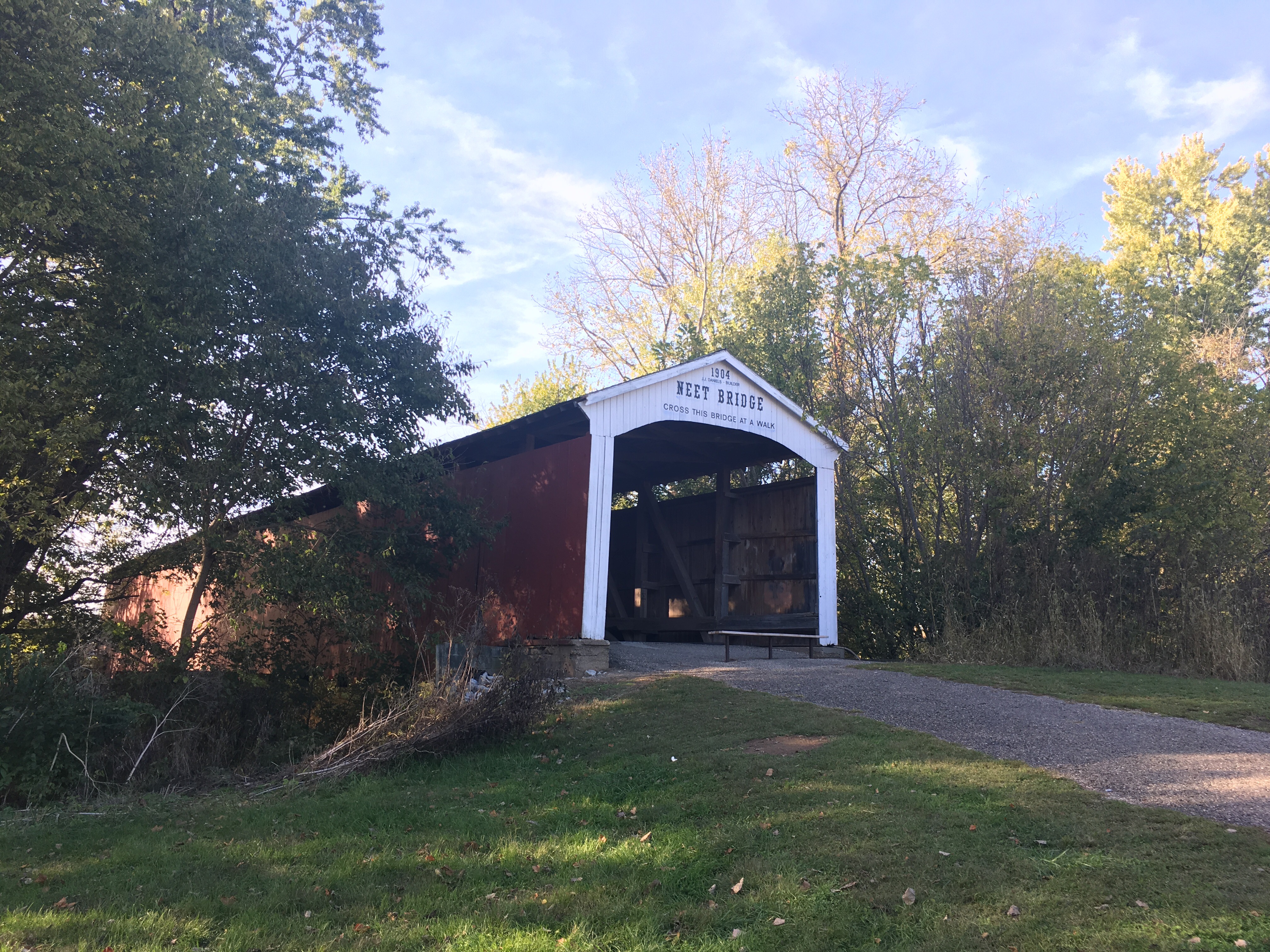Covered Bridges, Crafts, and Country Roads: Fall Fun at the Parke County Covered Bridge Festival

Fall always flies by at record speed for me, and this year is no exception. It’s one of the busiest times of the year for me at work and home. I love autumn events, but finding time to check off my fall bucket list can be a challenge. I decided to take a day off work so Mom and I could attend the covered bridge festival since we hadn’t been in several years. The Parke County Covered Bridge Festival is a ten day event which begins on the second Friday in October each year. It is like the Indiana State Fair of October.

History of the Covered Bridge Festival
The festival takes place in Parke County, Indiana, home of 31 covered bridges, and boasts attendance of over 2 million people each year, making it Indiana’s largest festival. It dates back to 1957, when a former resident of Rockville, Indiana, Mrs. Charles Cole, brought friends back to her home county to show them the covered bridges throughout the area. At that time there were 41 bridges, but they were only able to locate 20 of them since so little information existed about the bridges, many of which are off the beaten path on little country roads without signs to direct you to them. She wrote a letter to the local newspaper complaining about the lack of information, and the editor published her letter plus an editorial about the missed tourism opportunity for the county, which was struggling economically. The next year the first covered bridge festival was held over three days on the Rockville courthouse square. Maps were provided for tourists looking for information about the bridges; bridge routes were marked with cardboard signs; bus tours were provided; and refreshment stands were stationed along the routes. The crowds grew each year and so did the event. The festival expanded over the years to ten communities in Parke County (Rockville, Bridgeton, Mansfield, Mecca, Rosedale, Coxville, Marshall, Montezuma, Bloomingdale and Tangier), and more people now come for the crafts, antiques and other items offered up by vendors than to see the covered bridges. I love the covered bridges, and need to come back to find them all sometime other than October, when there is less traffic.

Getting There
Factoring in the festival traffic and slow speeds required by some of the narrow roads, it’s about a two hour trek west from my house. I’m definitely a city girl, and would rather be on a busy interstate than driving along country roads. We got stuck behind slow moving combines on their way to harvesting fields, both going to and coming back from the festival. At one point we were behind a logging truck, and I kept thinking the logs were going to slide off and roll down the road at any given moment. The signs we passed were amusing both in terms of what they were advertising for sale and the straightforward nature of the messages. My favorite was “campfire wood, guinea pigs and straw.” That seemed like a fun combination to buy. Then there was the sign stating simply “Church Ladies Sale” which reminded me of the 1980s SNL skits. One sign advertised persimmon pulp for sale. (I had no idea why one would want to go out of their way to buy persimmon pulp, so I had to look that up when I got home. Apparently it’s a “versatile food component” used in jams, baked goods, and persimmon pudding.)

Covered Bridges
Parke County, Indiana has earned the title “Covered Bridge Capital of the World” because it has more remaining covered bridges than any other county in the U.S. One question you might have is why Parke County? The main reason is because it’s a poor rural county of only 17,000 residents, so there wasn’t money to tear down and replace the bridges with concrete and steel. The reason the bridges were built covered was to protect the wooden structure. It worked: the oldest remaining covered bridge in Indiana is 163 years old. We saw Billie Creek Covered Bridge along our route, stopped at Neet Covered Bridge just off Bridgeton Road, and of course saw Bridgeton Covered Bridge which is at the heart of the Bridgeton festival site. Both Neet and Bridgeton are bypassed bridges, so you can’t drive through them, but several drive through bridges still exist in the area, which can be a harrowing experience since they’re so narrow and old. There are several more bridges nearby, a few of which I’ve seen during a past festival trip when we got a little lost trying to find them. I’m itching to get back and see more of them!
The original covered bridge spanning Big Raccoon Creek in Bridgeton was built in 1868 and made for a beautiful, historic centerpiece for the festival. Unfortunately, an arsonist burned it down it in 2005; locals compared the loss to losing a member of their family. The bridge was rebuilt in 2006 but it still pains me it’s not the original since it’s been billed as “Indiana’s most famous covered bridge.” All of the material and labor to rebuild the bridge was donated by vounteers.
The Neet Covered Bridge was built by J.J. Daniels in 1904 at age 78 and spans Little Raccoon Creek. It was named for nearby landowners. Neet was repainted in 1989 by a Rockville boy scout troop. This was a peaceful relaxing rest stop on our way back home after experiencing the crowds at Bridgeton.





Bridgeton
Bridgeton is an old mill town and the mill next to the covered bridge has a fascinating history. The Bridgeton Mill is the oldest continually operating mill in the Midwest, producing fresh stone ground products with 200 year old French Buhr stones, such as different kinds of cornmeal, buckwheat flour, and mixes. It was built in 1823, destroyed by fire in 1868, and rebuilt in 1870. Mike and Karen Roe bought the mill in 1995, years after first seeing it in the 1970s. They restored the mill and made Bridgeton one of the festival’s most popular sites to buy arts, crafts and antiques. Mike also became the miller at the Indiana State Fair in 2015, running the Meadows Mill grist mill. There are other historic buildings in Bridgeton such as a general store, town hall, Old Bridgeton School, a house and barn built in 1878 and the Case Log Cabin built in 1822. All of the buildings are open for shopping during the festival and filled with vendors. Tents are set up too and go on for miles. Fair-type food vendors are plentiful at the festival. We shared a delicious wood-fired pizza. It was my first time seeing a portable wood-fired pizza oven on wheels, and it was just as delicious as wood-fired pizza from a restaurant. We also had pumpkin ice cream, perfect for the sunny, warm fall day!







More information about the Covered Bridge festival and bridges can be found here. If you live in Indiana or Illinois, I definitely recommend a day trip see the covered bridges and attend the festival if you’ve never been.

Related
Related Posts
A Last Look at Winter Before Leaping into Spring
Happy Leap Day! I am excited to see February end, and the first month of…
Related
September’s Sweet Sunflowers
Is there anything more cheerful than a field of sunflowers? It’s like a…



Marilee | 29th Oct 17
That is a good recap of the Covered Bridge Festival and the history is interesting too. It is my favorite fall festival. So glad we did it this year! One year Dad and I searched out all the Covered bridges except five on the west routes as we ran out of daylight! There was also one we could not find on the black route, but I can’t remember which one now. We took photos of each one and drove thru the ones we could. It was a fun day off the beaten path. 🍁
Denise Breimeir | 30th Oct 17
I remember hearing about your trip and seeing photos. Do you still have the photos handy? Also, I was thinking you had a book about the covered bridges, but I could be wrong. I’m glad we went this year. I always have fun with you!
Wendie | 30th Oct 17
I can’t believe I’ve lived in Indiana for 25+ years and have never been to this festival! I love covered bridges. Love your photos and history of the bridges.
Denise Breimeir | 31st Oct 17
I was surprised when I found out how old the festival is, and how many people attend! No wonder it was a mob on a Friday! I love covered bridges too. One of these days I will find more of them!